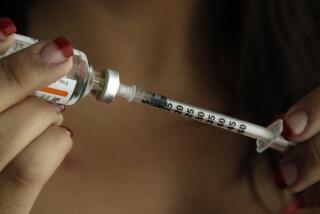New Method to Fight Diabetes Found Effective
- Share via
In a finding that is likely to dramatically change the way diabetes is treated, federal researchers have concluded that breaking the daily insulin requirement into smaller, more frequent doses and adjusting dosage size to achieve “tight control” of blood sugar levels significantly reduces the number of complications that diabetics suffer.
For more than 50 years, scientists studying diabetes have been plagued by a central question: Are the eye, kidney, nerve and heart damage associated with diabetes caused by the same disease process that produces diabetes itself? Or are they the result of the wide swings in blood sugar levels caused by injecting insulin once or twice a day?
The answer is the insulin injections, according to the results of a 10-year study of 1,441 diabetics that was conducted by the National Institute of Diabetes and Digestive Diseases and reported Sunday in Las Vegas at a meeting of the American Diabetes Assn.
The recommended regimen of more frequent insulin doses was found to be so effective that the study was terminated prematurely so that all participants could begin following it.
“This is a seminal event in the history of diabetes research,” almost as important as the discovery of insulin, said Dr. Phillip Gordon, director of the diabetes institute, which funded and coordinated the study. “Diabetes is one of the major public health problems of the United States, and this provides a dramatic and clear message about the treatment of that disease.”
“This is a landmark study of major clinical importance,” said Dr. F. Xavier Pi-Sunyer, president of the American Diabetes Assn. The study, he added, gives ADA “a much stronger bully pulpit” from which to urge physicians and the 1.4-million insulin-dependent diabetics to adopt the new regimen.
Insulin-dependent diabetes, also known as Type 1 diabetes, results when the insulin-secreting cells of the pancreas are destroyed by the body’s immune system for reasons that are not clear.
Insulin helps cells throughout the body take in sugars from the blood and use them for energy. In its absence, cells must use stored fats for energy. The accumulation of byproducts from that process causes a variety of problems, ranging from intense thirst and excessive urination to coma and death.
The immediate symptoms of diabetes can be controlled by administering one or two daily doses of insulin recovered from animals or produced by genetic engineering techniques. But this process allows wide swings in blood sugar levels, swings that many researchers have long suspected produce the severe complications of diabetes.
Those complications include blindness caused by diabetic retinopathy, kidney damage, peripheral nerve damage (loss of nerves in the arms and legs) and cardiovascular problems. Retinopathy is the leading cause of new cases of blindness in adults, and diabetes is the most common cause of kidney failure.
About 25,000 Americans must have their lower limbs amputated each year as a result of peripheral nerve damage and circulatory problems caused by diabetes, and diabetics are two to five times as likely as other people to suffer heart attacks and cardiovascular problems. Overall, diabetes is the fourth leading cause of death in the United States and costs the country $40 billion per year in health care costs and missed work, according to the diabetes association.
The 1,441 subjects in the study, known as the Diabetes Control and Complications Trial, were randomly divided into two groups. The control group continued with their previous regimen, taking standard insulin doses once or twice a day and monitoring blood sugar levels once per day.
Those in the intensive treatment group took three or four doses of insulin per day or used an insulin pump that delivered small doses continuously. They also checked their blood sugar levels at least four times per day, and adjusted each insulin dose to reflect actual blood sugar levels, their diet and any exercise they undertook.
When a preliminary analysis of the data was completed, the numbers were “fairly spectacular,” according to Dr. Orville Kolterman, head of the study group at UC San Diego, where 62 subjects were treated.
Intensive treatment reduced diabetic retinopathy 76%, prevented or delayed progression of diabetic kidney disease by as much as 56% and reduced peripheral neuropathy 60%. There were not enough cardiovascular events in the two groups to determine whether intensive treatment was also effective there, Gordon said, “but the trends are very encouraging.”
The researchers cautioned that many of the participants may develop the complications, but that they will nonetheless enjoy many extra years of good health as a result of the regimen.
Most researchers believe that the results can be better. The average blood sugar level in the intensive treatment group remained about 40% above normal because some patients did not stick to the regimen as strictly as physicians hoped. Overall, said Dr. Oscar Crofford of Vanderbilt University, the reduction in complications was highest in those patients who maintained the best control of blood-sugar levels.
The only complication associated with intensive control was a threefold increase in the risk of hypoglycemia--low blood sugar--which can make the subjects feel faint or cause them to pass out. The researchers noted a small increase in the number of minor traffic accidents and property damage as a result of such fainting spells. They thus recommended that the strict control regimen not be adopted by individuals with a family history of hypoglycemia or another disease that makes hypoglycemia more dangerous; such individuals represent only a very small proportion of diabetics, however.
Researchers also recommended that the new regimen not be adopted for children under age 7, who would have difficulty complying, and by the very elderly.
Most researchers are confident that the study results can be extrapolated to the 13 million Americans with Type 2, or insulin-independent, diabetes. In these patients, the pancreas still produces insulin, but the body does not use it correctly. They show the same wide swings in blood sugar levels and they develop the same complications as the Type 1 diabetics.
It is thus likely that tight control will also be effective in reducing their complications, Pi-Sunyer said, “but we really need another clinical trial to find out.”
The new regimen will de-emphasize the importance of physicians in caring for diabetics and bring new importance to the nurse-educators, dietitians, nutritionists and behaviorists who most interact with the patients, most researchers agreed. Unfortunately, Gordon concluded, there are not enough of these care-givers to bring tight control to every diabetic in the country. More will have to be educated before patients can reap the full benefits of the study, he said.






